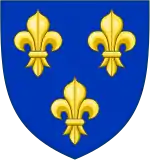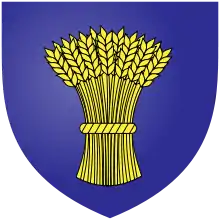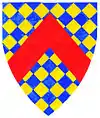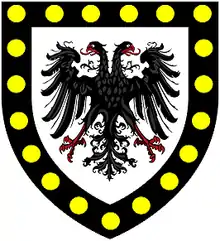Ancient and modern arms
Ancient and modern are terms used in heraldry to differentiate two different coats of arms used at different periods by a family or other bearer. Reasons for changing arms have been numerous, the most famous being the 1376 change in the French royal arms by Charles V of France to show three fleurs-de-lis instead of semee de lis, possibly to symbolize the Holy Trinity. The reasons for other changes were more prosaic, for example where a court of chivalry ordered a change or differencing where two families claimed the same arms, as in the famous case of Scrope v Grosvenor. The resulting two versions of arms are referred to as "France ancient" and "France modern", "Grosvenor ancient" and "Grosvenor modern".
List of examples
| Family | Ancient arms | Modern arms | Date of change | Notes |
|---|---|---|---|---|
| Capet (Royal arms of France) |  Arms of France ancient: Azure semée-de-lis or |
 Arms of France modern: Azure, three fleurs-de-lis or |
1376 | See article Royal Arms of France |
| Portugal (Royal arms of Portugal) | .svg.png.webp) Portugal ancient: Argent, five escutcheons crosswise the dexter and sinister ones pointing to the center azure each semée of argent plates |
.svg.png.webp) Portugal modern: Argent, five escutcheons in cross azure each charged with as many argent plates in saltire, all within bordure gules semée of seven castles or |
1245 (first version of Portugal modern)/1485 (current version) | See article Coat of arms of Portugal |
| Denmark (Coat of arms of Denmark) | .svg.png.webp) Denmark ancient: Or semée of waterlily pads gules, three leopards passant azure crowned or langued gules. |
 Denmark modern: Or, three lions passant in pale azure crowned or langued gules, nine lily pads gules. |
1819 | Originally the lions were heraldic leopards facing the viewer and the number of hearts (officially blazoned as waterlily pads) was not defined and could be much larger than today. The lions were defined as heraldic lions and the number of hearts specified to nine in 1819. |
| Grosvenor |  Grosvenor ancient: Azure, a Bend Or |
 Grosvenor modern: Azure, a Garb Or |
1389 | See article Scrope v Grosvenor |
| Gorges |  Gorges ancient: Lozengy or and azure |
 Gorges modern: Lozengy or and azure, a chevron gules |
1347 | See article Warbelton v Gorges |
| Percy |  Percy ancient: Azure, five fusils conjoined in fess or |
 Percy modern: Or, a lion rampant azure |
1273-1314 | See article Henry de Percy, 1st Baron Percy |
| Talbot |  Talbot ancient: Bendy of ten argent and gules |
 Talbot modern: Gules, a lion rampant within a bordure engrailed or |
See article Baron Talbot. Modern arms are of Rhys Mechyll (d.1244), Prince of the Welsh House of Dinefwr, grandson of Rhys ap Gruffydd), and wife of Gilbert Talbot (d.1274), grandfather of Gilbert Talbot, 1st Baron Talbot (d.1345/6) | |
| Cantilupe |  Cantilupe ancient: Gules, three fleurs-de-lis or |
 Cantilupe modern: Gules, three leopard's faces jessant-de-lys reversed or |
1275-1282 | See article Thomas de Cantilupe |
| Killigrew |  Killigrew ancient: Gules, three mascles or[1] |
See article Arwenack | ||
| Scudamore | _of_SCUDAMORE%252C_of_Kentchurch%252C_Holme-Lacy%252C_and_Ballingham%252C_Herefs.png.webp) Scudamore ancient |
_of_SCUDAMORE%252C_of_Kentchurch%252C_Holme-Lacy%252C_and_Ballingham%252C_Herefs.png.webp) Scudamore modern |
||
See also
References
- Dunkin, p.20; Tregellas, p.116, footnote. These mascle arms are also visible on the Wrey monument (see File:BlancheKilligrew TawstockChurch.JPG) now in Tawstock Church, Devon, (moved from St Ive Church, Cornwall) of Blanche Killigrew (d.1595) and her husband John Wrey (d.1597) of Trebeigh, St Ive, Cornwall. The monument was moved from St Ive Church to its present position against the east wall of the nort transept of St Peter's Church, Tawstock, Devon, in 1924 by Sir Philip Bourchier Sherard Wrey, 12th Baronet (1858-1936), of Tawstock Court.(Pevsner, Nikolaus & Cherry, Bridget, The Buildings of England: Devon, London, 2004, p.790)
- The bezantée bordure indicates a connection to the ancient Earls of Cornwall(See Martin Lister-Killigrew's History of the Killigrew Family : "What their arms were before is uncertain, but from ye Heralds Office we know that in the time of Rchard Duke of Cornwall, brother of Henry III, and King of the Romans, he gave to Ralph de Killigrew the spread eagle, with the border of Cornwall, which undeniably denotes the family to be of consideration, so high back as those antient times"
This article is issued from Wikipedia. The text is licensed under Creative Commons - Attribution - Sharealike. Additional terms may apply for the media files.
